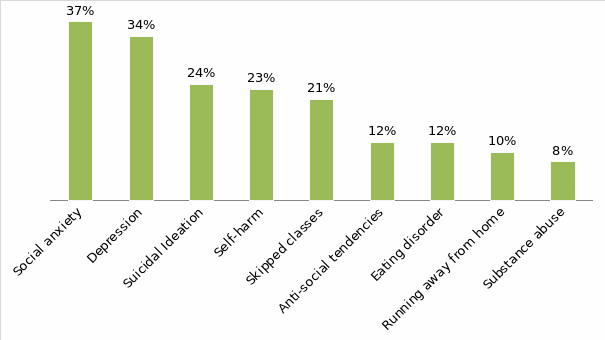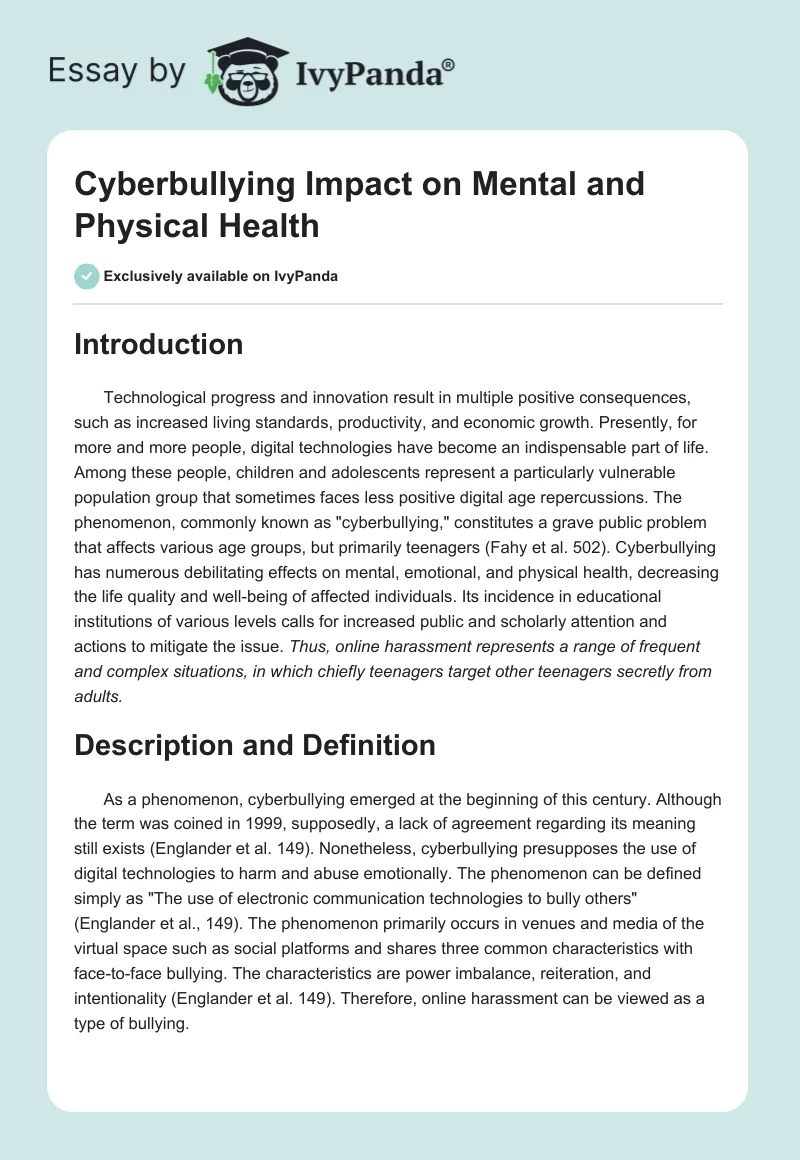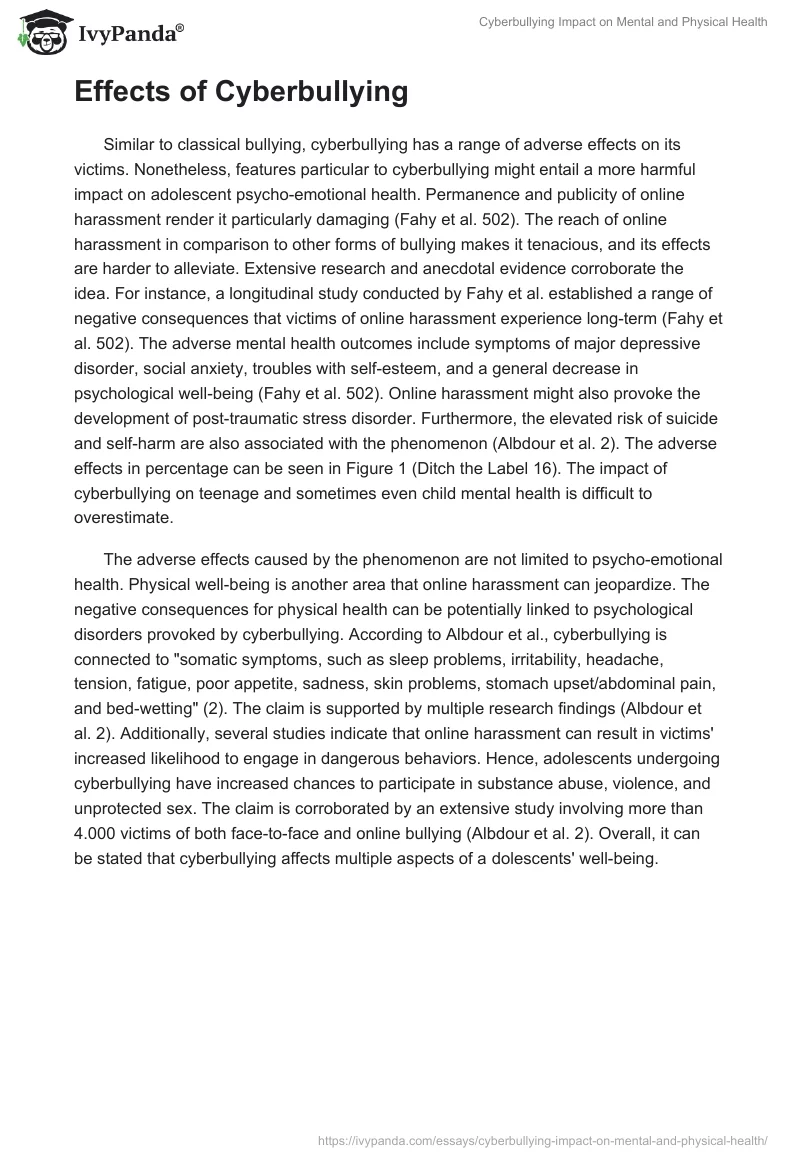Introduction
Technological progress and innovation result in multiple positive consequences, such as increased living standards, productivity, and economic growth. Presently, for more and more people, digital technologies have become an indispensable part of life. Among these people, children and adolescents represent a particularly vulnerable population group that sometimes faces less positive digital age repercussions.
The phenomenon, commonly known as “cyberbullying,” constitutes a grave public problem that affects various age groups, but primarily teenagers (Fahy et al. 502). Cyberbullying has numerous debilitating effects on mental, emotional, and physical health, decreasing the life quality and well-being of affected individuals. Its incidence in educational institutions of various levels calls for increased public and scholarly attention and actions to mitigate the issue. Thus, online harassment represents a range of frequent and complex situations, in which chiefly teenagers target other teenagers secretly from adults.
Description and Definition
As a phenomenon, cyberbullying emerged at the beginning of this century. Although the term was coined in 1999, supposedly, a lack of agreement regarding its meaning still exists (Englander et al. 149). Nonetheless, cyberbullying presupposes the use of digital technologies to harm and abuse emotionally. The phenomenon can be defined simply as “The use of electronic communication technologies to bully others” (Englander et al., 149).
The phenomenon primarily occurs in venues and media of the virtual space such as social platforms and shares three common characteristics with face-to-face bullying. The characteristics are power imbalance, reiteration, and intentionality (Englander et al. 149). Therefore, online harassment can be viewed as a type of bullying.
Effects of Cyberbullying
Similar to classical bullying, cyberbullying has a range of adverse effects on its victims. Nonetheless, features particular to cyberbullying might entail a more harmful impact on adolescent psycho-emotional health. Permanence and publicity of online harassment render it particularly damaging (Fahy et al. 502). The reach of online harassment in comparison to other forms of bullying makes it tenacious, and its effects are harder to alleviate. Extensive research and anecdotal evidence corroborate the idea. For instance, a longitudinal study conducted by Fahy et al. established a range of negative consequences that victims of online harassment experience long-term (Fahy et al. 502).
The adverse mental health outcomes include symptoms of major depressive disorder, social anxiety, troubles with self-esteem, and a general decrease in psychological well-being (Fahy et al. 502). Online harassment might also provoke the development of post-traumatic stress disorder. Furthermore, the elevated risk of suicide and self-harm are also associated with the phenomenon (Albdour et al. 2). The adverse effects in percentage can be seen in Figure 1 (Ditch the Label 16). The impact of cyberbullying on teenage and sometimes even child mental health is difficult to overestimate.
The adverse effects caused by the phenomenon are not limited to psycho-emotional health. Physical well-being is another area that online harassment can jeopardize. The negative consequences for physical health can be potentially linked to psychological disorders provoked by cyberbullying. According to Albdour et al., cyberbullying is connected to “somatic symptoms, such as sleep problems, irritability, headache, tension, fatigue, poor appetite, sadness, skin problems, stomach upset/abdominal pain, and bed-wetting” (2).
The claim is supported by multiple research findings (Albdour et al. 2). Additionally, several studies indicate that online harassment can result in victims’ increased likelihood to engage in dangerous behaviors. Hence, adolescents undergoing cyberbullying have increased chances to participate in substance abuse, violence, and unprotected sex. The claim is corroborated by an extensive study involving more than 4.000 victims of both face-to-face and online bullying (Albdour et al. 2). Overall, it can be stated that cyberbullying affects multiple aspects of a adolescent’ well-being.

Reactions to the Phenomenon
Online harassment can evoke a variety of emotional reactions from its principal actors – victims, witnesses, and bullies. Emotional responses to the phenomenon are varied and can depend on different variables. First and foremost, it can make an individual feel unsafe, powerless, insecure, and demoralized. A relatively recent study conducted by Erişti and Akbulut concentrates on investigating possible behavioral reactions to cyberbullying, including revenge, countermeasure, avoidance, negotiation (Erişti and Akbulut 4). The researchers measured how different individuals react depending on their gender and education level.
Thus, based on a questionnaire, it was revealed that female participants were more prone to negotiation and avoidance, while male participates in revenge and countermeasure (Erişti and Akbulut 4). Depending on the educational level, university students seem to be more likely to prefer countermeasure and somewhat less likely to avoid the problem. On the other hand, high school students are more prone to avoidance and negotiation (Erişti and Akbulut 5). Gender and education level seems to be significant predictors for the behavioral response.
In addition, emotional responses can correlate with Internet habits. For instance, Internet duration has a somewhat considerable impact (Erişti and Akbulut 5). This factor directly correlates with revenge and negotiation. On the other hand, individuals’ perception of their capability to utilize digital devices to resolve problems and manage situations is linked to a preference for countermeasures. Furthermore, the factor negatively correlates with the tendency for avoidance (Erişti and Akbulut 5). Thus, how individuals react to online harassment can depend on their gender, technological habits, and education level.
Bystander reactions to online harassment are also of significant scientific interest. Online harassment witnesses can react in several ways: prosocially, antisocially, or indifferently (Cao and Lin 459). Prosocial behavior implies intervening, trying to stop the bully, or consoling the victim. Antisocial behavior presupposes becoming a perpetrator of cyberbullying. Indifferent reaction means that a witness merely ignores the situation. How a bystander responds might also depend on their gender.
According to Cao and Lin, in their study, female participants were more likely to respond prosocially, while male participants were antisocially (Cao and Lin 460). The researchers explain the correlation by stating that “girls generally had more empathy than boys, allowing them to feel and experience other persons’ emotions and thoughts more perceptively” (Cao and Lin 462). Bystander reactions seem to be dependent on similar factors that predict victims’ behavioral responses.
Online Harassment and Law
Despite the considerable adverse effects of online harassment on victims’ mental and physical health, cyberbullying is seemingly not treated as a criminal matter in numerous countries. According to El Asam and Samara, certain vagueness surrounds the legal status of cyberbullying, and from the juridical perspective, the notion is in limbo (131). For example, although the number of online harassment victims continually rises in the United Kingdom, bullying face-to-face or online is not criminalized (El Asam and Samara 131). Yet, the absence of a law specifically targeting cyberbullying does not mean that it is not considered a crime.
While a specific law outlawing online harassment does not seemingly exist, cyberbullying prosecution can occur under different legal provisions. For instance, even though there is no law criminalizing cyberbullying in the United States, it commonly overlaps with other laws (Gordon para. 12). If a person is tormented online because of their ethnicity, gender, sexuality, or religion, the harassment can be prosecuted under anti-discrimination federal laws (Gordon para. 12).
Similarly, sharing someone’s intimate photos or videos, also a form of cyberbullying, can be considered distribution of child pornography even if the distributor is underage themselves. Regarding penalties, since there is no unity on the legal level, the penalties can vary from suspension or expulsion to incarceration (Gordon para. 25). Hence, cyberbullying is frequently prosecuted as different types of harassment, discrimination, or impersonation.
Schools and different educational institutions are often entrusted with managing and controlling the problem. Typically, schools are supposed to penalize online harassment, and school officials are responsible for enforcing sanctions against it (Gordon para. 13). Supplementary disciplinary procedures are implemented if a case of online harassment with the participation of a school’s student succeeds. Whether it occurs on the school territory or outside does not matter (Gordon para. 13). Educational facilities are in control of gathering data on cyberbullying allegations. Overall, depending on the gravity of outcomes for the victim, cyberbullying can be a severe criminal offense and should be taken seriously.
Helping to Cope with Online Harassment
Online harassment affects the youngest and most vulnerable categories, disproportionately. Responsible adults, caregivers, parents, and teachers play an essential role in helping children and adolescents cope with it. Adults can provide the necessary guidance on healthy ways to respond to the problem. They can help adolescents and children access professional help and resources to prevent the development of mental health problems. Considering that cases when cyberbullying results in fatal outcomes that exist and increase, caregivers and teachers are responsible for noticing and appropriately reacting so that underage person receives help before harming themselves.
The Internet is abundant with resources that allow adults to recognize signs indicating that a child is being cyberbullied and detailed action plans. For instance, such organizations as the National Bullying Prevention Center and Teens Against Bullying organize events and assist the affected people. Several free parents’ guidelines for online harassment also can be found online. The guidelines usually contain general recommendations and step-by-step instructions specifying, for instance, how to react if an adolescent confesses that they are harassed online. Thus, many online and community resources are available for underage victims and adults.
Conclusion
The relatively new phenomenon of cyberbullying is a significant public issue, the prevalence of which in teenagers’ and children’s lives is consistently growing. Online harassment negatively impacts psycho-emotional and physical states in multiple ways – it leads to depression, social anxiety, low self-esteem, insomnia, bed-wetting, et cetera.
The reactions to the problem vary across the population, depending on several variables such as gender and technological habits. Law is fundamental for mitigating the problem; nevertheless, a unified legal approach is absent in many countries. Yet, the absence of the law targeting cyberbullying does not mean that it is without legal implications – online harassment entails various penalties. Adults play a crucial role in ensuring that bullies face legal consequences and victims access the necessary help.
References
Albdour, Maha et al. “The Impact of Cyberbullying on Physical and Psychological Health of Arab American Adolescents.” Journal of Immigrant and Minority Health, 2019, pp. 1–10.
Cao, Bolin, and Wan-Ying Lin. “How do Victims React to Cyberbullying on Social Networking Sites? The Influence of Previous Cyberbullying Victimization Experiences.” Computers in Human Behavior, vol. 52, 2015, pp. 458–465.
Ditch the Label. The Annual Bullying Survey – 2017. Ditch the Label, 2017. Web.
El Asam, Aiman, and Muthanna Samara. “Cyberbullying and The Law: A Review of Psychological and Legal Challenges.” Computers in Human Behavior, vol. 65, 2016, pp. 127–141.
Englander, Elizabeth et al. “Defining Cyberbullying.” Pediatrics, vol. 140, 2017, pp. 148–151.
Erişti, Bahadır, and Yavuz Akbulut ” Reactions to Cyberbullying Among High School and University Students.” The Social Science Journal, 2018, pp. 1–11.
Fahy, Amanda E. et al.” Longitudinal Associations Between Cyberbullying Involvement and Adolescent Mental Health.” Journal of Adolescent Health, vol. 59, no. 5, 2016, pp. 502–509.
Gordon, Sherri. “Understanding the Legal Ramifications of Cyberbullying.”Very Well Family, 2020. Web.


